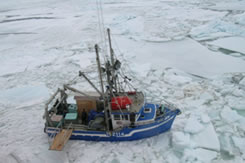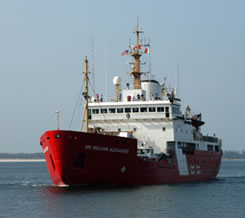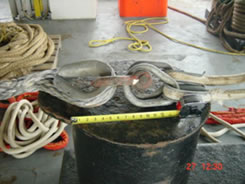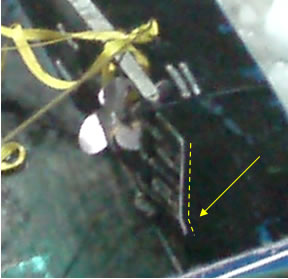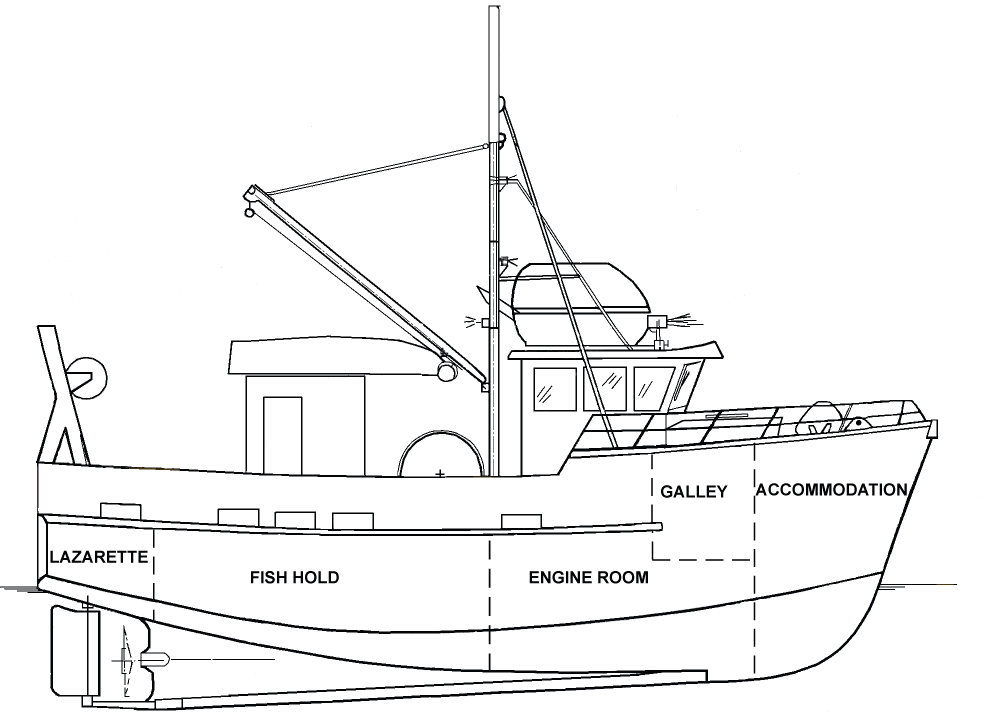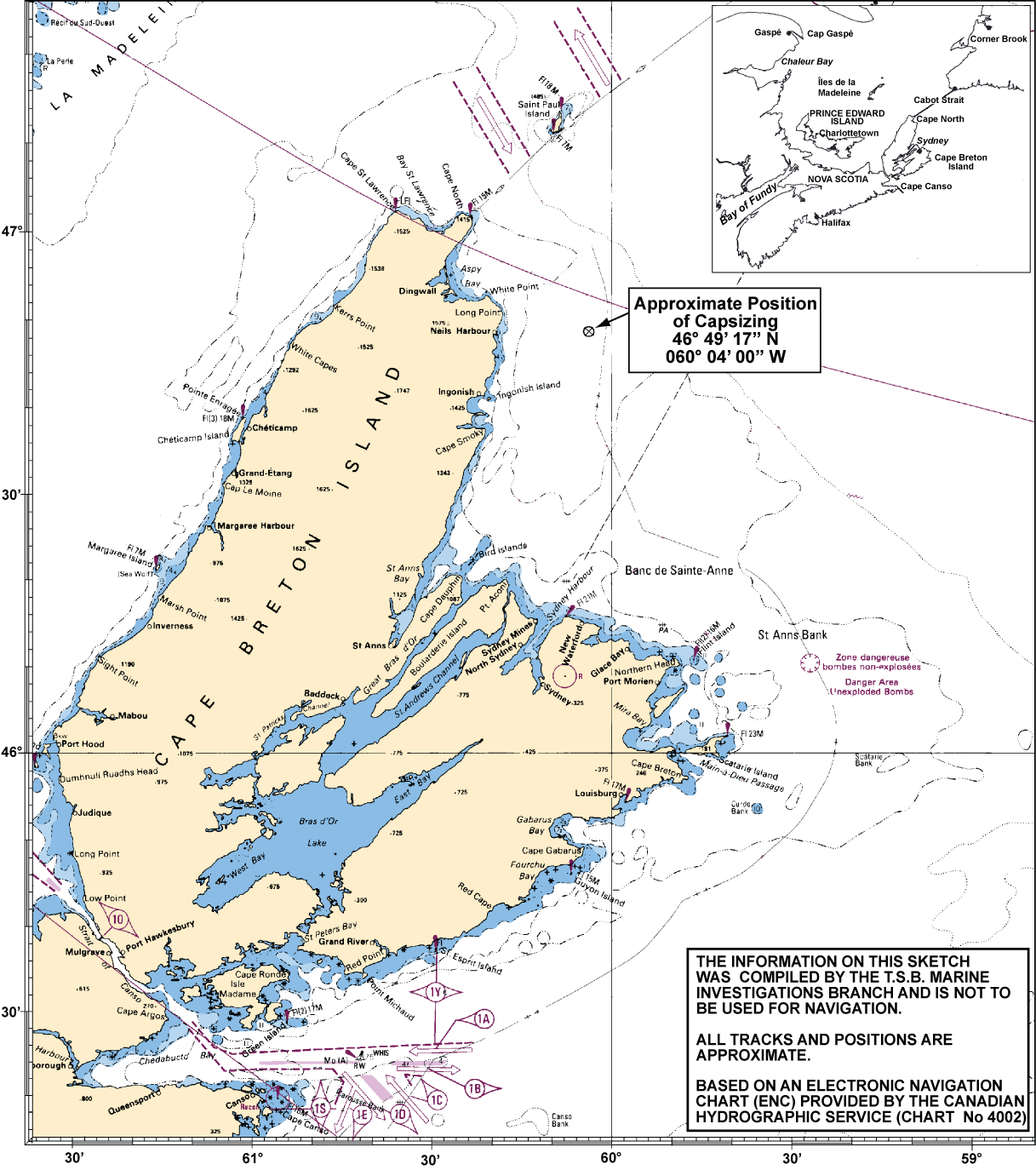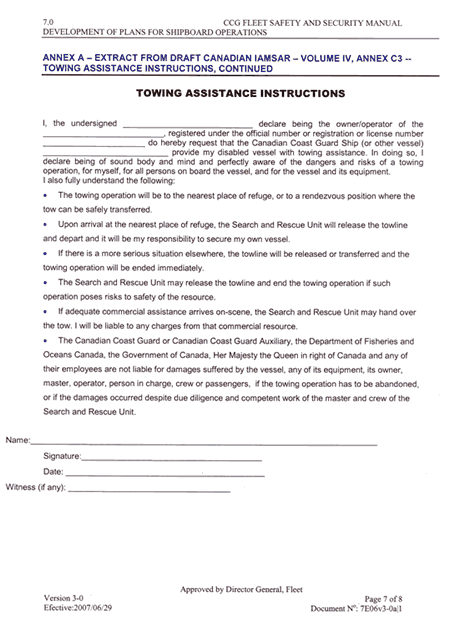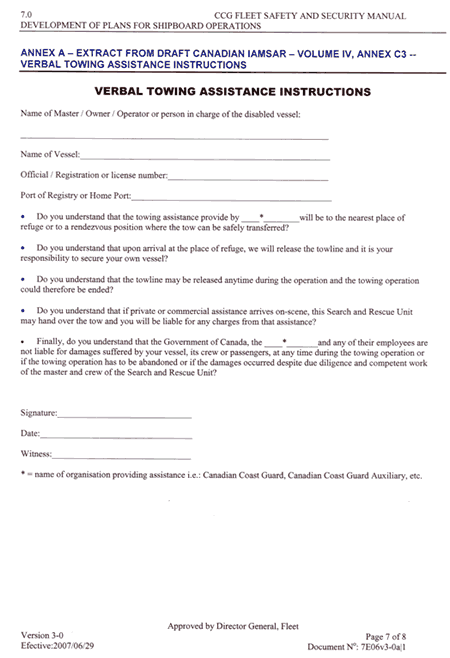Capsizing while under tow
Small fishing vessel L'Acadien II
18 nm Southeast of Cape North
Cape Breton Island, Nova Scotia
The Transportation Safety Board of Canada (TSB) investigated this occurrence for the purpose of advancing transportation safety. It is not the function of the Board to assign fault or determine civil or criminal liability. This report is not created for use in the context of legal, disciplinary or other proceedings. See Ownership and use of content. Masculine pronouns and position titles may be used to signify all genders to comply with the Canadian Transportation Accident Investigation and Safety Board Act (S.C. 1989, c. 3).
Summary
On the morning of 29 March 2008, the small fishing vessel L'Acadien II, with six crew members on board, capsized, 18 nautical miles off Cape Breton, Nova Scotia, while being towed in ice by the light icebreaker CCGS Sir William Alexander. Two crew members were quickly rescued by another small fishing vessel. Several hours later, three deceased crew members were recovered from the overturned vessel by Department of National Defence search-and-rescue technicians. One crew member is still missing and presumed dead.
Ce document est également disponible en français.
Factual information
Particulars of vessels
| Name of vessel | L'Acadien II | Sir William Alexander |
|---|---|---|
| Official number | 811285 | 807685 |
| Port of registry | Charlottetown, P.E.I. | Ottawa, Ont. |
| Flag | Canada | Canada |
| Type | Small fishing vessel | Aids to Navigation Tender/ Light Icebreaker |
| Gross tonnage | 34.36 | 3728.01 |
| LengthFootnote 1 | 12.56 m | 78.39 m |
| Displacement | 40 tonnes (est. | 4750 tonnes (est.) |
| Draught | Forward: 1.5 m (est.) Aft: 1.9 m (est.) |
Forward: 5.6 m Aft: 6.0 m |
| Built | 1988, Caraquet, N.B. | 1987, Sorel, Que. |
| Propulsion | One Cummins diesel engine developing 224 kW, single propeller | Three Bombardier diesel engines totalling 6677 kW, driving two propellers, and providing a bollard pull of 68.3 tonnes |
| Cargo | None | None |
| Crew members | 6 | 27 |
| Registered owner(s) | Les Pêcheries Bruno Bourque Inc., Étang-du-Nord, Quebec | Department of Fisheries and Oceans, Ottawa, Ont. |
Description of vessels
L'Acadien II
The L'Acadien II was a small fishing vessel of closed construction, with an all-aluminum welded hard-chine hull. The hull below the main deck was subdivided by three transverse watertight bulkheads enclosing (from forward) the crew accommodation, the galley and the engine room, the fish hold, and a lazarette containing the hydraulic steering gear and a pair of fuel tanks and ballast tanks. The wheelhouse was located in a deckhouse forward of midships, and a single weathertight door on the starboard side led from the wheelhouse onto the main deck aft. In 2004, the shell was reinforced with 12.7 mm aluminum doubling plate fitted over the existing plating in way of the waterline for navigating in ice during the seal hunt (see Appendix A).
CCGS Sir William Alexander
The Canadian Coast Guard ship (CCGS) Sir William Alexander was built in 1987 as a major aids to navigation tender/light icebreaker. The vessel is of closed construction with an all-steel welded ice-strengthened hull. The diesel electric propulsion system consists of two reversible electric motors driving two fixed-pitch propellers whose rotation speed is infinitely variable between 10-180 rpm. In addition to a 600 kW bow thruster, the CCGS Sir William Alexander is also fitted with a heavy lift crane on the main deck, with a capacity of 19.43 tonnes.
History of the voyage
On 26 March 2008 at 1800,Footnote 2 the fishing vessel L'Acadien II with a crew of six departed Cap-aux-Meules, Îles-de-la-Madeleine, Quebec, to participate in the annual seal hunt in the Gulf of St. Lawrence. After encountering high concentrations of heavy ice that evening, the vessel shut down for the night. The next day the CCGS Des Groseilliers, which was in the area in support of the Department of Fisheries and Oceans' (DFO) administration of the annual seal hunt, provided icebreaker assistance by escorting several fishing vessels, including L'Acadien II, toward more navigable ice conditions, within the vicinity of St. Paul Island, Nova Scotia (see Appendix B).
On the morning of March 28, L'Acadien II sustained damage to its steering system after going astern in ice and could no longer be steered to starboard. The CCGS Des Groseilliers rendered assistance by sending two engineering personnel to the stricken vessel. After troubleshooting the steering system for approximately 30 minutes, the problem was diagnosed to be external to the vessel and below the waterline. The engineering personnel returned aboard the CCGS Des Groseilliers and, shortly afterward, the CCG vessel departed the scene on a search-and-rescue (SAR) tasking. At 1521, L'Acadien II made a request for assistance through Sydney Marine Communication Traffic Services (call sign VCO). Additionally, status updates for the request for assistance were made by the fishing vessel through VCO at 1642 and 1724. At 1859, Joint Rescue Coordination Centre (JRCC Halifax) tasked the CCGS Sir William Alexander to escort the small fishing vessel Madelinot War Lord and to attempt to assist L'Acadien II to the nearest practical port as required.
The CCGS Sir William Alexander departed Sydney, Nova Scotia, at 1926, arriving alongside L'Acadien II at 2242. After passing a towline and bridle to L'Acadien II, the CCGS Sir William Alexander commenced the tow and proceeded toward the Madelinot War Lord, which was beset in ice and had previously reported taking on water. As the tow began, two crew members on board L'Acadien II were sleeping in the forward accommodation and shortly thereafter the master turned in as well.
With L'Acadien II in tow, the CCGS Sir William Alexander passed alongside the Madelinot War Lord so that it could fall in behind L'Acadien II. The three vessels then proceeded toward the nearby small fishing vessel Wendy Cora and at least seven other small fishing vessels that were likewise beset in ice.
The tow over the next hour was reported as uneventful, with L'Acadien II yawing slowly from side to side within the constraints of the track created by the CCGS Sir William Alexander. The towing speed varied according to the ice conditions, ranging from 1.6 knots to 4.1 knotsFootnote 3, with an average speed of 2.6 knots. During this time, L'Acadien II occasionally engaged its clutch and used engine propulsion in an attempt to assist.
Around 0100 a fourth crew member went below to his bunk, leaving two crew members in the wheelhouse of L'Acadien II. Shortly thereafter, L'Acadien II and the CCGS Sir William Alexander entered an area of very open drift iceFootnote 4 where the pack ice no longer constrained L'Acadien II within the track of the CCGS Sir William Alexander. L'Acadien II soonFootnote 5 sheered to port and went on a track approximately 60° off the centreline of the CCGS Sir William Alexander. While the vessel was sheering to port, the towline was now forming an angle with the centreline of the vessels, and, at the same time, the starboard bridle became slack.
At 0107, just before L'Acadien II encountered and struck a large piece of ridged, first-year ice square on the stem, the fishing vessel's engine was put full-ahead in an attempt to break the ice. The significant inertia of the CCGS Sir William Alexander,Footnote 6 coupled with the tow's own inertia, drove the fishing vessel partially onto the ice. This reduced the vessel's buoyancy and stability. At the same time, a girdingFootnote 7 moment was created by the towline and the vessel capsized on its starboard side, flooding the vessel through the partially open wheelhouse window.
It was observed that the vessel's propeller was still turning quickly for some time after the capsizing.
Towing arrangement
Prior to hooking up the tow, the officer of the watch (OOW) on the CCGS Sir William Alexander read the verbal towing assistance instructions (Towing waiver - see Appendix C and Appendix D) over the very high frequency (VHF) radiotelephone to the master of L'Acadien II who agreed to its terms. All communication between the two vessels was in English and the language used posed no barrier to comprehension. The waiver was agreed to by L'Acadien II.
In keeping with normal marine practices for towing in ice, the towline was kept short. The towline consisted of a two-legged bridle, each 15 m in length, shackled to a 38-mm double-braided nylon towing hawser 12 m in length (see Photo 3). Each of the eyes of the 29 mm braided nylon bridle were passed through fairleads and secured over the mooring bitts on the bow (port and starboard) of L'Acadien II.
On the CCGS Sir William Alexander, the towing hawser was led through the aft centerline fairlead and secured around the towing bollard. This arrangement resulted in a stern-to-stem towing distance of about 22 m.
Two lookouts were posted on the quarterdeckFootnote 8 adjacent to the towing bollard and were supplied with a portable VHF radiotelephone on channel 19 for
direct communication with the bridge, as well as an axe to sever the towline in case of an emergency. The lookouts were given instructions to monitor the tow, communicate any concerns regarding the tow, and to sever the towline at their discretion. The tow was also being continually monitored by the Commanding Officer (C/O) of the CCGS Sir William Alexander on the bridge.
Accordingly, as L'Acadien II approached the piece of ice, the C/O put the propulsion motors full astern and ordered the towline to be severed. Simultaneously, as the vessel struck the ice, one of the lookouts radioed the bridge and ran to the towing bit in order to cut the towline. However, the CCGS Sir William Alexander could not be stopped nor the towline severed quickly enough to prevent L'Acadien II from being pulled partially onto the ice, hauled back into the water on its starboard side and capsizing under the girding moment induced by the force from the towline. A radio call from the Madelinot War Lord to the CCGS Sir William Alexander was heard but not acknowledged due to the high workload immediately following the occurrence.
L'Acadien II under tow
At 2259, after the two vessels agreed on the towing arrangement, the CCGS Sir William Alexander requested that a person be kept on the bridge of L'Acadien II at all times, to monitor the tow on channels 6 and 16. This was the last radio communication between the two vessels.
Shortly after the towing commenced, the master of L'Acadien II left the bridge to turn in. Two crew members remained in the wheelhouse to monitor the tow and communications. During the tow, the engine was left running onboard L'Acadien II, and occasionally, when encountering ice, its main engine clutch was engaged forward so as to reduce tension on the towline. The CCGS Sir William Alexander was not aware that these manoeuvres were being carried out.
While underway, the L'Acadien II yawed slowly back and forth within the track created by the icebreaker, with a preference toward the port side.
Search and rescue (CCGS Sir William Alexander)
After L'Acadien II capsized, three crew members escaped from the overturned vessel but only two surfaced. They were quickly recovered by the Madelinot War Lord. The CCGS Sir William Alexander stopped, launched its fast-rescue craft (FRC) to look for additional survivors, and turned around. When the FRC went alongside the overturned vessel, its crew could hear noisesFootnote 9 coming from within the hull and so they requested that a call be made for divers. While a search for local divers was being carried out ashore, the overturned vessel was monitored with arrangements made to secure and stabilize the hull alongside the CCGS Sir William Alexander. Initially, a lifting strap was put around the propeller shaft and supported using the heavy lift crane. As the bow began to settle in the water, a second strap was rigged around the bow and attached to a second hook from the crane. An attempt was made to lift the vessel from the water, but its weight far exceeded the crane's capacity.
At this point, 81 minutes since the capsizing, noises were still being heard within the overturned vessel, the decision was made to cut access ports into the hull using a rescue saw.Footnote 10 Several cuts were made in the hull, but the depth and close spacing of the framing made access impossible. The hull was then sealed using wooden wedges and high-expansion foam to try to re-establish the integrity of the hull.
Search and rescue (Department of National Defence)
Immediately after it was determined that there were persons still missing and possibly trapped within the hull of the overturned L'Acadien II, JRCC Halifax tasked several SAR aircraft to assist in search-and-rescue efforts. Rescue 903, a Cormorant helicopter from 413 Squadron, Greenwood, Nova Scotia, was tasked at 0123 and launched at 0335. Rescue 307, a Hercules aircraft also from 413 Squadron, was tasked at 0137 and departed Greenwood at 0300.
Rescue 307 arrived on scene at 0355, and commenced an air search for possible survivors. Rescue 903 arrived on scene at 0520, lowered two SAR technicians directly to the CCGS Sir William Alexander, and then joined the air search. After a brief discussion between the C/O and SAR technicians, two additional SAR technicians were requested from Rescue 307 and they parachuted to the surface where they were picked up by the Madelinot War Lord.
The SAR technicians entered the water at 0652 and commenced a thorough search of the interior and exterior of the overturned vessel. The body of the one victim was recovered at 0700, a second at 0705, and a third at 0753. The fourth crew member could not be located within the overturned hull. Once it was determined that no bodies remained inside the vessel, the underwater search was terminated at 0821. Rescue 903 and Rescue 307 continued the air search until they ran low on fuel. They departed the scene at 0540 and 0820, respectively.
Rescue 910, a Cormorant helicopter from 104 Squadron, Gander, Newfoundland and Labrador, was tasked at 0919, launched at 1021, and arrived on scene at 1220. Rescue 910 continued the air search for the missing crew member until 1430, when it departed the scene.
The SAR effort continued until 1706, when the CCGS Sir William Alexander was stood down and requested to proceed to Sydney, Nova Scotia.
Damage to Vessel
L'Acadien II
The damage to the steering system (see Photo 4) was such that the vessel could not be steered on a steady course or turn to starboard. The rudder movement was reported to be from 45° port to 5° port,Footnote 11 and this caused a natural tendency to turn to port, even when full starboard helm was applied. It was also observed that the uppermost part of the rudder was bent to port.
Following the occurrence, the overturned vessel remained afloat for several days and is presumed to have sunk.
Environmental impact
Pollution created by the capsizing of the L'Acadien II and the subsequent release of pollutants was quickly dissipated through evaporation and wind/wave action.
Injuries to persons
L'Acadien II
Two crew members were quickly rescued from the water by the Madelinot War Lord suffering from minor hypothermia. The bodies of three deceased crew members were subsequently recovered from inside the overturned vessel. A fourth crew member is missing and presumed deceased.
Vessel certification
L'Acadien II
L'Acadien II was last inspected by Transport Canada (TC) on 24 March 2008, whereupon an inspection certificate was issued for a non-passenger vessel exceeding 15 tons but not exceeding 150 tons. The certificate, which was due to expire on 23 March 2009, allowed the vessel to operate on voyages up to Near Coastal Voyage, Class I, limited Home Trade II.Footnote 12
CCGS Sir William Alexander
The CCGS Sir William Alexander is subject to regular inspection by TC as a non-passenger ship greater than 150 tons. It was last issued an inspection certificate on 15 October 2007. The vessel maintains an Arctic Class 2 designation, and classification society Det Norske Veritas (DNV) verified on 15 January 2008 that the vessel's safety management system complies with the International Management Code for the Safe Operation of Ships and for Pollution Prevention (ISM Code).
Personnel certification
L'Acadien II
The master of L'Acadien II held a Fishing Master III certificate as well as a certificate as a watchkeeping engineer for a motor-driven fishing vessel. Both crew members on watch at the time of the occurrence held Fishing Master IV certificates. At least four crew members had marine emergency duties (MED) training.
CCGS Sir William Alexander
The Commanding Officer and the other officers of the CCGS Sir William Alexander held certificates valid for the class of vessel and the type of voyage being undertaken. All the officers and crew had MED training, which was consistent with TC requirements, according to the position they held on board the ship.
Deck watch complement
L'Acadien II
At the time of the occurrence, the deck watch consisted of two crew members.
CCGS Sir William Alexander
At the time of the occurrence, the deck watch consisted of five persons: the C/O had the con and was stationed at the port manoeuvring console, the OOW was on a landing aft of the starboard bridge wing, the quartermaster was on the wheel, and the two lookouts were monitoring the tow on the quarterdeck.
Personnel history
L'Acadien II
The operator on the bridge at the time of the occurrence had five years' experience fishing, four of which had also been spent sealing.
CCGS Sir William Alexander
The C/O had 27 years of experience in the Canadian Coast Guard, two of them as master. The OOW had 30 years of experience. The two lookouts posted at the towing station had 18 and 32 years of experience, respectively.
Weather and ice conditions
Weather at the time of the occurrence was winds north by east at 10-15 knots, overcast with light snow flurries and an air temperature of −1°C. General ice conditions were reported as 9/10ths to 10/10ths first-year ice. L'Acadien II was clearly visible from the CCGS Sir William Alexander.
The forecast for the area at the time was winds northeast at 10-15 knots increasing to 15-20 knots overnight and to northwest at 25-30 knots later in the day.
Lifesaving equipment
Lifesaving equipment aboard L'Acadien II included six lifejackets, six immersion suits, a four-person rigid liferaft with a hydrostatic release, a boat suitable for four persons, two lifebuoys, and one float-free emergency position-indicating radio beacon (EPIRB).
The speed at which the vessel capsized precluded the donning of lifejackets or immersion suits, and no EPIRB signal was received.
On 17 July 2008, an Ovatek liferaft belonging to L'Acadien II, along with survival suits and lifejackets, was found on a beach near St. Esprit, Nova Scotia. On 03 August 2008, a life ring belonging to the fishing vessel was discovered near Port Bickerton, Nova Scotia.
Post-occurrence towing trials
The CCG carried out two separate sets of post-occurrence trials towing similar vessels to L'Acadien II.Footnote 13 TSB had input into the setup and conduct of these trials, which were done to simulate, as accurately as possible, the conditions under which the tow took place. The TSB also validated the results.
During the first set of towing trials, conducted on June 4 in Bedford Basin, Nova Scotia, a sister ship to the CCGS Sir William Alexander, the CCGS Edward Cornwallis, was employed to tow a vessel approximately the same length as L'Acadien II. The simulation used a bridle/towline of similar length, material, and configurationFootnote 14. To simulate the deflected rudder, the tow's rudder was set at varying degrees to port, including hard over. The tow was also kept within the same speed parameters recorded in this occurrence - that is, the tow's engine was idle, and the clutch was disengaged.
The tow displayed a strong tendency to remain behind the CCGS Edward Cornwallis. Numerous settings of rudder angles were then tried in an attempt to duplicate the sheer to port that was reported during the occurrence. At no time was the position of rudder angle alone enough to duplicate such a sheer. It was only in combination with an added force - in this case, as soon as the tow engaged the clutch, without any increase in engine speed or application of throttle - that it sheered noticeably and quickly to port.
During the second set of towing trials, conducted on July 19 at Baie des Chaleurs, New Brunswick, another sister ship to the CCGS Sir William Alexander, the CCGS Martha L. Black, was employed to tow a fishing vessel virtually identical to L'Acadien II. Based on new information received after the first trial, the bridle/towline setup was modified to more accurately reflect the conditions at the time of the occurrence, and the tow's rudder was set at varying degrees to both port and starboard.Footnote 15
Once again, the tow exhibited a strong tendency to remain behind the CCGS Martha L. Black, and it was not until the tow engaged its clutch that it sheered noticeably and quickly to port and began to overtake the CCGS Martha L. Black.
Analysis
Construction of vessels for operation in ice
In Canadian waters south of the 60th parallel, there are no regulatory restrictions placed on navigation as a result of the annual ice pack. A previous TSB reportFootnote 16 notes that small fishing vessels are neither designed nor constructed for navigation in ice. Notwithstanding, the Department of Fisheries and Oceans (DFO) policies effectively restrict all but these vessels from participating in the seal hunt, where they are exposed to significant ice-induced loads (pressure and impact.)
For a vessel to be considered seaworthy it must be sufficient in its materials, construction, equipment, and crew for the trade in which it is employed.Footnote 17 Where vessels are expected to navigate in ice-infested waters, such as during the seal hunt, strengthening or reinforcing of the ship is necessary beyond what is required for open-water operations.
Recognizing this need to strengthen vessels navigating in ice-infested waters, Transport Canada (TC) has included measures in the proposed Fishing Vessel Safety Regulations and Construction Standards for Commercial Fishing Vessels. At the time of the occurrence, however, there was no requirement for L'Acadien II to be ice-strengthened.
In this occurrence, the hull plating of L'Acadien II had been reinforced. However, the scantlings of the shafting arrangement were not increased accordingly or sufficiently, and the rudder was not suitably protected for a vessel navigating in ice.Footnote 18 While going astern in heavy ice, L'Acadien II suffered damage to its steering system, preventing it from proceeding on its own.
Canadian Coast Guard towing assistance
Typically, a disabled vessel requests assistance through a Marine Communication Traffic Services (MCTS) station or directly contacts the Joint Rescue Coordination Centre (JRCC). Upon receipt of an assistance request, JRCC then evaluates the nature of the request. If it is determined that the vessel is in distress, suitable search-and-rescue (SAR) units are tasked. If the vessel is merely disabled, other options are considered, including, for example, the availability of commercial towing. In the case of fishing vessels, the availability of any nearby fishing vessels willing and able to assist is also considered. If no other resources are available, a Coast Guard SAR unit is then tasked.
For small fishing vessels operating in open water in Eastern Canada, experience has shown that aid options are essentially limited to Coast Guard and its auxiliary vessels. Commercial towing is not generally considered, and Coast Guard vessels are routinely tasked.
There are certain risks associated with towing in ice. These include towing small vessels which may not be designed to navigate in ice and using a towing arrangement which may impact the vessel's stability characteristics.Footnote 19 Moreover, if there is a size differential between the two vessels, the manoeuvring characteristics and inertia of the towing vessel may affect those of the vessel being towed.
It is rare, however, for small fishing vessels to request a tow in ice. The Canadian Coast Guard has not developed comprehensive policies, procedures, guidelines, or practices to address these associated risks. As a result, Canadian Coast Guard icebreakersFootnote 20 are tasked without considering all the available options or risks associated with such an endeavour.
Towing assistance instructions
In principle, when a tow in ice is being considered, both vessels must consider the risks involved.
The disabled vessel must agree to a set of routinely administered instructions prior to towing assistance being provided. This document, titled Towing Assistance Instructions (see Appendices C and D), is either read and signed by the vessel in question, or agreed to verbally via VHF radiotelephone. The Towing Assistance Instructions is effectively a waiver meant to absolve the Government of Canada (and any of its agencies and employees) from any liabilities suffered while towing. This document does not, however, stress or otherwise indicate the inherent risks and precautionsFootnote 21 to be taken while being towed by another vessel in either open or ice-infested waters.
Details of towing arrangement
Once the decision to tow has been made, the focus shifts to how to best carry it out.
Variables include tow length, towline force and direction, weather and sea conditions, ice conditions (if present), lookout, emergency contingency planning, tow speed, communications, and the steerage capabilities of the vessel under tow.
The difference in displacement between the two vessels can also be a significant factor. In this case, with a displacement approximately 120 times that of the smaller vessel, the CCGS Sir William Alexander had a far greater inertia - making it difficult to stop suddenly should this be required.
According to Dunderdale,Footnote 22 high concentrations of ice necessitate a standard "short tow" arrangement, which differs from conventional long tows used in open waters.Footnote 23 Although there are other variations in the techniques used when towing short in ice-infested waters, these apply to larger commercial vessels and were not applicable in this case.
In a short tow, the distance between the towing vessel and the tow can vary from a few metres to several ship-lengths. A short tow helps to maintain control, minimizes contact between ice and towline, allows the propeller wash to reduce ice accumulation ahead of the tow, and allows the towing vessel to provide greater protection from the ice. Due to the hazardous nature of the operation and the unpredictability of ice conditions, towing short is carried out at reduced speeds.
In this occurrence, the initial length of the towline was discussed between the CCGS Sir William Alexander's C/O and chief officer, with the final determination based on what they considered to be the optimal positioning of L'Acadien II behind the CCGS Sir William Alexander. If too short, for example, the tow would have been vulnerable to ice resurfacing from underneath the stern of the CCGS Sir William Alexander. If too long, the track would have closed in ahead of the tow, due to the high concentration of ice. In addition, two crew members were to be posted on the quarterdeck to act as lookouts and to continue to monitor the tow.
Once the CCGS Sir William Alexander moved ahead slowly, the tow was monitored from the quarterdeck. L'Acadien II also confirmed via VHF that the tow under way was satisfactory.
Post-occurrence towing trials
During the two sets of post-occurrence towing trials, it was observed that the tow, with its clutch disengaged, displayed a strong tendency to remain within the centreline track of the CCG vessel towing it.
In an attempt to duplicate L'Acadien II's sheer to port, the towed vessel's rudder was set at varying angles to simulate a damaged steering system. However, none of these angles - including hard over - proved sufficient to duplicate the sheer. This is consistent with the natural tendency of any vessel to assume the position of least resistance to any prevailing conditions, such as wave, wind, current, and tow, etc.
There are two reasons for this: first, the bridle on a short tow has an inherently stabilizing effect. Second, with the CCGS Sir William Alexander moving ahead at less than four knots, the rudder's tendency to move L'Acadien II to port would have been insufficient to overcome the transverse component of the force acting on the tow from the towline.
It was only in combination with an added force - in this case, as soon as the tow engaged its clutch and the propeller began providing additional thrust - that the rudder produced a sheer to port.
There are several possible sources for this added force:
- A sudden speed or course change by the CCGS Sir William Alexander: for example, a rapid acceleration or sudden turn to starboard would have created additional force on the towline that could possibly have contributed to L'Acadien II's loss of directional stability;
- Ice interference;
- Tide and/or wind; or
- An increase in the speed of the tow.
Of these sources, the first three can be ruled out as unlikely:
- An examination of the CCGS Sir William Alexander's electronic chart data revealed only a one-degree course change. Moreover, the increase in speed was so small and gradual - from 2.91 knots to 3.02 knots over a period of one minute - as not to be a factor.
- There was no ice interference. The fishing vessel was in relatively open water behind the icebreaker until hitting the ice pan.
- The route being followed at the time of the occurrence was approximately 103° or east by south with winds from the north by east at 10-15 knots. The known current sets to the south-southeast in this area of Cabot Strait at a speed varying from 0.5 to one knot. Therefore, the resulting current and wind would have caused the vessels to drift to starboard (and not to port) while steering on the course they were on. Furthermore, set and drift calculations based on the CCGS Sir William Alexander's immediate post-capsizing position determined a set and drift to the southeast at approximately 0.5 to one knot.
This leaves a possible speed increase from L'Acadien II.
As noted earlier, during the towing process, L'Acadien II occasionally engaged its clutch and used engine propulsion in an attempt to assist the tow. Moreover, the propeller was observed to be still turning quickly for some time after the capsizing.
The two towing trials indicate that ahead propulsion was required to cause the tow to sheer. During each trial, when the vessel under tow engaged its clutch and the propeller began to turn, the flow of water over the rudder increased, causing the vessel to accelerate and sheer to port. Coupled with the decreasing tension on the towline, the turning momentFootnote 24 from the rudder was great enough to overcome the transverse component of the towline's force acting forward of the pivoting point.Footnote 25
Therefore, it was a speed increase from L'Acadien II - most likely caused by an engaged clutch - that, coupled with the deflected rudder, caused the vessel to sheer.
Findings
Findings as to causes and contributing factors
- L'Acadien II suffered the damage to its steering system while going astern in heavy ice, thus preventing it from proceeding on its own.
- The clutch was likely engaged in the ahead position with the engine running as it left the centreline track. Combined with the deflected rudder, this would have caused L'Acadien II to sheer to port, whereupon it struck a large piece of ice.
- Once the vessel struck the ice, the combined effects of the towline force and direction, the fishing vessel's ahead propulsion, and the inertia of the CCGS Sir William Alexander propelled L'Acadien II partially onto the ice and then back into the water on its starboard side, whereupon it subsequently capsized.
- L'Acadien II was not designed, constructed, or adequately modified to navigate in ice.
Findings as to risk
- The Canadian Coast Guard has no comprehensive safety policies, procedures, guidelines, or practices that address the risks associated with towing small vessels in ice.
- Numerous small fishing vessels continue to operate during the seal hunt in ice conditions for which they were neither designed nor constructed.
Other findings
- The emergency position-indicating radio beacon (EPIRB) signal from L'Acadien II was never received.
- The language used posed no barrier to communication between the vessels.
Safety action
Action taken
Fisheries and Oceans Canada
Three days after the occurrence, the Department of Fisheries and Oceans (DFO) issued Fleet Circular FC 07-2008, Suspension of the Towing of Small Vessels with Persons Onboard While in Ice. This document instructs masters that, until further notice, all Canadian Coast Guard vessels are directed not to take into tow, while in ice, any small vessels which have persons aboard. In particular, it states that:
The tasking authority [Regional Operations Centre, or the Joint Rescue Coordination Centre / Maritime Rescue Sub-Centre]; in consultation with the commanding officer and based on the on scene assessment, should consider other options to render assistance such as, but not limited to, the following:
- provide assistance to find alternate towing arrangements and standby to provide icebreaker escort for the tow if required;
- standby until ice conditions improve;
- render onboard technical assistance;
- assist crew to transfer to a safe place and tow with no persons onboard; or,
- as a last resort, assist crew to abandon vessel, transfer them to a safe place, leave the unoccupied vessel and depart the area.
However, in extremis, when lives are in immediate danger, the commanding officer shall take any actions he or she deems necessary to save lives, including towing in ice with persons onboard.
Safety recommendations
Design and construction of fishing vessels operating in ice
Commercial seal hunting is important to the livelihood of many Canadians in rural communities across Atlantic Canada, Quebec, and the North. In 2007, there were approximately 14 000 commercial licences issued to sealers, although not all licences were used.
In 2005, there were approximately 1800 vessels participating in the hunt, all of them under 19.81 m. Based on licensing information from 2007, a similar number of vessels are estimated to have participated during the 2008 season. Typically, these vessels are neither designed nor constructed for operating in ice: most are constructed of wood, fibreglass-reinforced plastic, or fibreglass over wood. Intended for open-water fishing and outfitted temporarily for participation in the hunt, their hulls, shafts, propellers, and rudders are seldom strengthened for navigation in ice-infested waters. In addition, without sufficient power and mass to navigate in ice, these vessels are susceptible to being beset and damaged.
The risks associated with using such vessels for seal hunting are well-recognized. Between 1990 and 2005, for example, 227 occurrences involving fishing vessels operating in ice-infested water were reported through Canadian Coast Guard radio stations. The majority of these occurrences involved hull damage, with a total of 21 vessels lost. During March and April of 2008, 41 requests for assistance were reported involving vessels in the seal hunt.
A 2000 report by the Maritime Search and Rescue, Newfoundland Region,Footnote 26 states that, in some instances, risk factors associated with sealing "quite often preclude any [insurance] coverage at all." This report further states that vessels engaged in the sealing industry "are finding that standard policies require as much as a $100 000 deductible."
In a 2005 TSB reportFootnote 27 on the sinking of the small fishing vessel Justin M off the Magdalen Islands, the Board found that when the vessel "became trapped in an ice field, the hull, which was not adequately strengthened for operations in ice, was crushed by the pressure, allowing ingress of water until it sank."
The Board is encouraged that Transport Canada is undertaking public consultations as it drafts the new Fishing Vessel Safety Regulations and the Construction Standards for Commercial Fishing Vessels. New fishing vessels over nine metres in length which operate in ice will be required to be suitably designed and constructed. However, the Board is concerned that this will not include all existing vessels; in 2005, for example, 58 per cent of vessels involved in the seal hunt were under 10.7 m.
Given that these existing vessels are likely to make up the majority of the sealing industry, current risk level will persist. The Board therefore recommends that:
The Department of Transport include in the proposed Fishing Vessel Safety Regulations adequate measures to ensure that all fishing vessels operating in ice-including those participating in the seal hunt-are structurally suited for their operating environment.
Transportation Safety Recommendation M08-04
Adequacy of CCG safe towing policy, procedures and practices
In this occurrence, L'Acadien II was disabled in ice and made a request for Canadian Coast Guard (CCG) assistance. In response, the CCGS Sir William Alexander was tasked to assist as required to the nearest port.
Prior to hooking up the tow, the officer of the watch on the CCGS Sir William Alexander read the Verbal Towing Assistance Instructions to the master of L'Acadien II, who agreed to the terms. These instructions are administered prior to towing, and effectively serve as a waiver, absolving the Government of Canada (and any of its agencies and employees) of any associated liabilities. The document does not, however, address the inherent risks nor offer safety measures for towing in open or ice-infested waters.
A towing operation can be a complex undertaking. Safe towing depends on a multitude of factors - including environmental conditions, size and condition of the tow, size of the assisting vessel, training and experience of crews, towline length, and speed and direction of the vessels involved - and requires close coordination and communication between the tow and the assisting vessel.
The Board notes the interim CCG suspension on the towing of small vessels with persons on board while in ice. However, small fishing vessels participating in the annual commercial hunt will continue to require assistance, especially for those unsuited for navigation in ice.
The Board, therefore, believes that permanent and comprehensive safety measures are required to address all of the risks associated with towing small vessels in ice. Recognizing that the timely provision of towing or other assistance to disabled vessels can be an effective way of meeting the national search-and-rescue objective of preventing loss of life and injury, the Board recommends that:
The Department of Fisheries and Oceans develops comprehensive safe towing policies, procedures, and practices that take into account all safety risks associated with towing small vessels in ice-infested waters.
Transportation Safety Recommendation M08-05
This report concludes the Transportation Safety Board's investigation into this occurrence. Consequently, the Board authorized the release of this report on .
